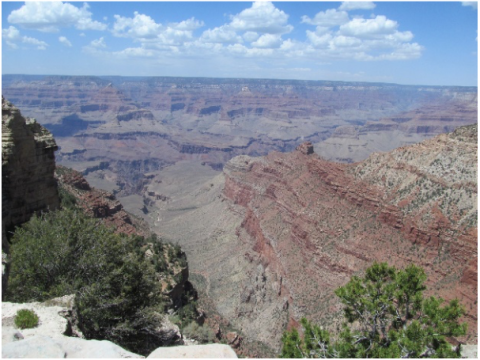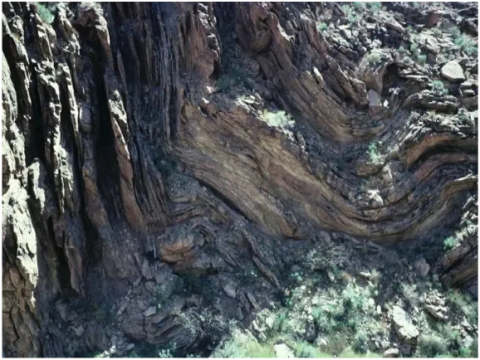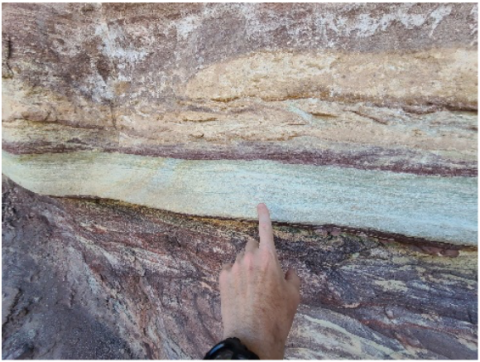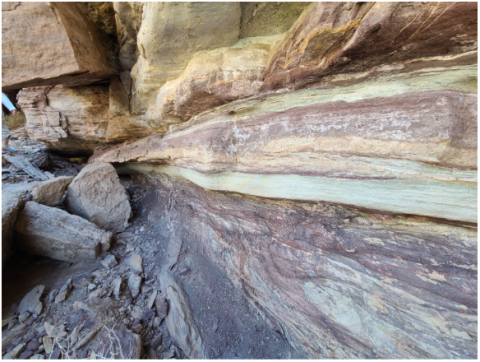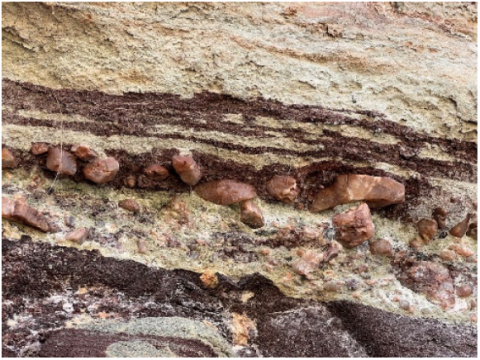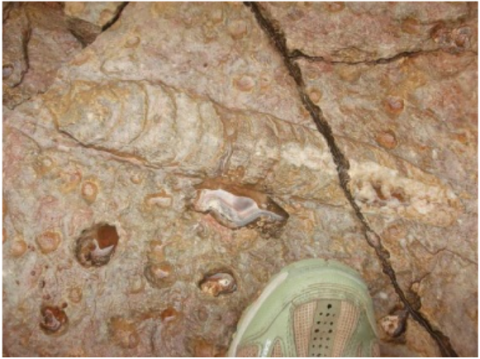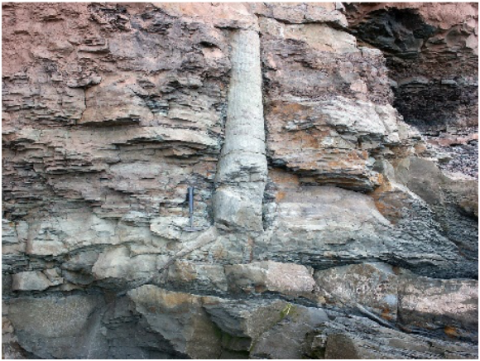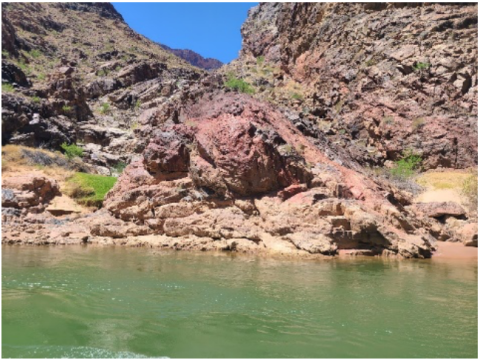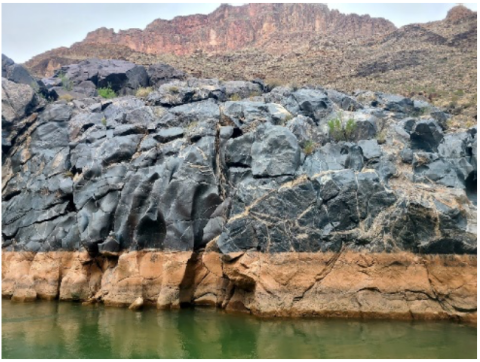Grand Canyon: Overwhelming Evidence for the Genesis Flood
Recently I was thrilled to be able to experience an adventure of a lifetime, rafting the Colorado River though a portion of the Grand Canyon with Canyon Ministries. This is a trip I had wanted to do for years, and the Lord opened a door of opportunity for me in late May. On one level the trip was a ton of fun. I have white-water rafted on several rivers in the east, including my favorite, the New River through the New River Gorge (“The Grand Canyon of the East”) in my home state of West Virginia, but nothing compared to this. On another level, however, the trip was so educational and faith-affirming! So many of my beliefs about geology, the age of the earth, and especially the Genesis flood of Genesis 6–9 were confirmed/reinforced on this trip. It’s almost as if God has given us a huge “Exhibit A” for the world-wide flood for all to see in one of the Seven Natural Wonders of the world! It is 277 miles long, over 6000 feet deep at its deepest point and averages ten miles in width and overwhelms you the first time you visit. In this article I would like to lay out six pieces of evidence that could be used as “exhibits” in a court of law for the reality of the Genesis flood. Most of the pictures are my own, but I have included a few others from the upper sections of the Canyon that my trip did not include.
The Evidence Described
Exhibit 1: Flat Sedimentary Layers
Note in Figure 1 the various distinguishable layers of rock. At Grand Canyon we see layer after layer of sedimentary rock (by definition formed as sediment drops out of water and later hardens into rock) beginning with the Tapeats Sandstone at the bottom and ending with the Kaibab Limestone at the very top. In between you have various layers of sandstone, shale, and limestone of various colors and thicknesses. All of them contain fossils. Remarkably, on our trip we could hardly ever see the actual top of the canyon because we were in the inner gorge and the canyon fans out above the inner gorge so far in either direction (literally miles across) that we could not see the top. Typically, the highest we could see when there were breaks in the inner gorge was the “Redwall Limestone,” which is only about halfway up the walls of the canyon!
Below the Tapeats Sandstone at the bottom we see the basement rocks (likely from the creation week) that are metamorphic rocks that have been changed/metamorphosized under heat and pressure at some point in the past. You also have some igneous (volcanic) rocks at various points typically visible as flows down the sides of the canyon from volcanic eruptions after the flood. What is significant about the sedimentary layers is that they are stacked flat as a pancake one on top of the other all the way up the canyon walls. Yet, they are supposed to each represent millions of years’ worth of time. One would expect to see evidence of erosion, of river valleys, of soil layers, etc., but we see none of that. Therefore, the sedimentary layers cannot be millions of years old! Also, we cannot date sedimentary rocks with any of the common dating methods like carbon dating (only good for about 50,000 to 100,000 years before carbon-14 is no longer detectable and is only used on bones, wood, etc., not rock), or radiometric dating (only good on igneous rocks). Rather, sedimentary rocks are dated using “index fossils” whereby the rocks are dated by the presence of certain fossils. One might ask, “How do they know the age of the fossils?” It’s based on the assumed age of the rocks the fossils are typically found in! This is a classic example of circular reasoning where millions of years is assumed from the onset! Granted, sometimes we find igneous layers above or below sedimentary layers that hypothetically could be dated and set “boundaries” for the ages above and below, but radiometric dating methods themselves are fraught with assumptions that are unverifiable, assume “deep time,” and tend to give ancient ages for rocks from modern volcanic flows. See my previous TASC article here for more of the problems with “deep time” and millions of years: https://tasc-creationscience.org/sites/default/files/2021-07/aug2021.pdf . So, the classic story about the Colorado River cutting out the Grand Canyon over millions of years is nothing more than a fairy tale.
Exhibit 2: Bent Sedimentary Layers
Figure 2 is a picture of several sedimentary layers at the Kaibab Upwarp section of the Canyon that are bent and folded at ridiculous angles that are impossible with solid rock. To the secular geologist this represents millions of years of time. Yet, the only way these rocks could be bent like this is if the uplift and bending occurred while the sediments were still soft and not yet solidified into solid rock. Therefore, they can't be millions of years old, and the layers represent one relatively short depositional process. If someone wants to deep dive farther into this, see the movie/documentary "Is Genesis History? Mountains After the Flood" where geologist Andrew Snelling scientifically investigates these bent rocks to prove they are normal sedimentary rocks (just like all the others around them) and there is no old-earth explanation for their existence. 1
Exhibit 3: Vast Extent of Sedimentary Layers
The Tapeats Sandstone, at the bottom of the canyon, stretches over most of the North American continent. It is not just local to the Canyon. Quoting from a resource edited by Tom Vail, the founder of Canyon Ministries:
The Tapeats Sandstone stretches from Mexico to eastern Canada and also north right through the Arctic Circle. Like many of the huge layers of the Grand Canyon, it has been labeled with different names. The different names were assigned locally when these layers were first discovered, before they were understood to be the same formation. 2
As a matter of fact, this vast extent phenomenon is true of all the layers. What kind of “wave” would be able to distribute that much sediment over that wide of an area? No doubt it was one of many tsunami waves caused by the volcanic and earthquake activity associated with the breakup of the “fountains of the great deep” as described in Genesis. From another resource by Tom Vail, quoting Tasman Walker:
In the walls of the Grand Canyon, horizontal layers of thick strata are exposed. They extend for thousands of square miles across several states of the United States. Because the sedimentary deposits are so huge, it is most unlikely that they were deposited in either the pre- or post-Flood eras. There was not enough time for slow geological processes to deposit such large quantities of sediment. 3
Clearly, something other than the forces we see in action today had to deposit these continent-wide sedimentary layers!
Exhibit 4: The “Great Unconformity” at the Base of the Sedimentary Layers
For me personally, I believe the most exciting part of my Grand Canyon adventure was to get to see, and touch, “The Great Unconformity.” In geology an “unconformity” is a surface that separates two different rock layers/strata that indicates a break in the sedimentary deposition (secular geologists often propose millions of year breaks but it could be brief breaks). At the very base of the “geologic column” world-wide, the “Great Unconformity” is where the basement rocks stop and the sedimentary layers (again laid down by moving water) begin. At the Grand Canyon it’s where the Tapeats Sandstone lies on top of metamorphic rock that has been basically scoured flat although much of it has also been bent so that it is no longer completely horizontal with the ground. There is a point in the lower Grand Canyon where the “Great Unconformity” becomes visible to the naked eye. Note Figures 3, 4, and 5. The tannish rock is the Tapeats Sandstone; the rocks beneath are metamorphic. I am pointing in Figure 3 to the Tapeats Sandstone at the “Great Unconformity.” Note also the rounded pebbles right beneath it that were washed in with the moving water as well (Fig. 5). Also, it should be noted that this same “Great Unconformity” can be seen world-wide, and significantly it is exactly where the fossils typically begin as well! In the so-called “geologic column” this first layer of sedimentary rocks is in the “Cambrian” period, and secular evolutionists even admit to what is called “The Cambrian Explosion of Life,” whereby creatures as complex as trilobites, jellyfish, sponges, etc. appear literally out of nowhere with no traces of ancestors. We are told that single-celled organisms are found buried in the “Precambrian;” but if that is the case, where are the two-celled organisms, four-celled organisms, etc. leading up to the extremely complex invertebrates we find buried in the Cambrian rocks (all creatures that lived at the bottom of the oceans)? Evolutionists have no answer to this dilemma!
Exhibit 5: The Fossils Within the Sedimentary Layers
As mentioned above, “The Great Unconformity” is where the sedimentary layers begin and, significantly, the fossils typically begin (world-wide not just at the Canyon). There are no fossils found in the metamorphic rocks which are below the “Great Unconformity.” Moving upward from the inner gorge, there are successive bands of brilliantly colored, fossil-bearing rocks in the outer/upper gorge. These layers represent roughly the lower half of the so-called “Geologic Column.” Erosion has washed away any rocks that were deposited above the Kaibab Limestone at the top of the Canyon.
From the Great Unconformity to the top of the canyon, the rocks are filled with fossils. Significantly from bottom to top we see marine creatures that once flourished in the oceans, indicating that the area was once covered by ocean waters. Even secular geologists recognize this, but they argue that there were multiple coverings and recessions over millions of years. For instance, they argue that the Redwall Limestone was formed from the gradual recession of a sea in the area (very different from a flood environment). It is fascinating that we find in the Redwall (claimed to be 340 million years old) millions (perhaps as many as four billion as documented by creation scientist Dr. Steve Austin) of fossilized nautiloids (in essence “shelled squids”) preserved in a six-to-seven foot bed within this deposit (see Figure 6, not from my trip). 4 Some of them are even preserved vertically, even though under evolutionary “uniformitarian” assumptions the Redwall was formed at about an inch for 4000 years. 5 Such vertically oriented nautiloids, which typically span about 12 to 18 inches, are examples on a smaller scale of “polystrate fossils,” which are more easily recognized as fossilized trees all over the world that extend through multiple sedimentary layers (see Figure 7 for an example). Clearly neither the nautiloids nor the trees were lying around for thousands of years waiting to be fossilized! What kind of catastrophic action could bury such a large group of sea creatures together over such a large area (on average, one nautiloid for every four square meters throughout the park and far beyond)?
Above the Redwall, beginning in the Supai layer and extending upward into the Hermit and Coconino layers, we found a myriad of fossilized footprints of amphibians and reptiles but no bones! This is a world-wide phenomenon where we find footprints of creatures in lower layers (supposedly millions of years earlier) than the first bones. Also, incredibly most all the footprints in the Coconino Sandstone are headed in the same direction! Are we to believe that all the animals were walking in the same direction for millions of years?
All of this, to me, clearly points to the reality of the Genesis Flood as the mechanism that formed the layers in the canyon, not slow and gradual accumulation over millions of years. In other words, the paleontology agrees with the geology of the canyon, and they both harmonize beautifully with the Genesis account!
Exhibit 6: The Gorge Through the Sedimentary Layers
Figures 8, 9, and 10 are pictures of the inner gorge of the canyon, which is for the most part all we could see with the naked eye. The inner gorge rocks in the lower canyon where we were rafting are below the “Great Unconformity” and are made up of metamorphic rocks such as schists, gneiss, and granites. Some of the colors were amazing to behold!
This elicits a logical question, however. What carved the gorge through the rock layers? The traditional secular, uniformitarian explanation is that the Colorado River acting over millions of years carved out the canyon! Yet, why don’t we see other such canyons all over the world if rivers have this erosional power? Furthermore, the Colorado river would have had to cut through solid rock going uphill at places. No, it was not a little bit of water and a whole lot of time that cut the canyon, 6 but a lot of water and a little bit of time! Granted, not all young-earth creationists agree on the specifics of when and how this happened. Some believe it was flood runoff that cut the canyon while others believe that a dam was breached from an ancient post-flood lake east of Grand Canyon. 7 Interestingly enough, even secular geologists have moved away from the traditional explanation, opting for more catastrophic explanations (albeit still holding onto millions of years of time), but these explanations still do not adequately explain what we see today.
The Evidence Applied
If I were arguing in a court of law, I would confidently assert that the six exhibits referenced above clearly point to the reality of the Genesis Flood as the mechanism that formed the layers in the canyon, not slow and gradual accumulation over millions of years. This being the case, there are significant theological implications! When a secular geologist views the Grand Canyon, they see millions of years and death as a part of the process that leads to you and me (molecule to man evolution). However, if we look at the same evidence from a biblical perspective, which is, quoting Ken Ham, “billions of dead things buried in rock layers laid down by water all over the earth,” we see death very differently. We realize that according to the Bible there was no death before Adam and the original sin. We realize that death is the penalty for sin from Genesis to Revelation. Romans 5:12 tells us that it was by one man’s sin (Adam) that death entered the world. There was no death before sin, at least not of the higher animals/”living creatures” (Hebrew: nephesh). Therefore, the fact that we see billions of dead things buried in Grand Canyon should remind us that there is penalty for sin and that God is a God who judges sin. The Flood and the Canyon it left behind are “Exhibit A” for that! However, there is good news/gospel (I Corinthians 15:3-4). The Bible also tells about a “Second Adam,” Jesus Christ, who came to take our death penalty in our place, so that we could be forgiven and live with God forever as if we had never sinned! Romans 6:23 states, “The wages of sin is death, but the gift of God is eternal life through Jesus Christ our Lord!” That is the greatest of all Good News!
On that note, I would like to allude to one final picture from my trip, Figure 11. I think I’ve saved the best for last because this is my favorite picture from my trip. I took it using the “panoramic” feature on my phone, and somehow, quite unexpectedly, I seem to have captured a rainbow in the background! I don’t know how, because it was not visible to the naked eye. The picture was taken early in the morning, and there had been no rain. How incredibly appropriate! In the midst of Exhibit “A” for the world-wide flood, God allowed me to capture a rainbow that He gave as the “Exhibit A” promise/reminder to Noah and all his descendants to never again bring another world-wide flood (Genesis 9:12–17). I can think of no picture more appropriate to close this article than a picture of a rainbow in the canyon! Obviously, this sign that God created has been co-opted by man for other purposes, but that does not and cannot negate God’s intended purpose for the rainbow.
Let me close with these thoughts. Just as the rainbow reminds us of the former point in human history when God judged the sin, wickedness, and rebellion of mankind by water, the Bible speaks of a future day when God will once again judge the sin, wickedness, and rebellion of the world, but this time with fire. II Peter 3:10 refers to that day. In context, that verse is even more applicable to this article. II Peter 3:3–10 is a fascinating prophecy about the last days and predicts that men, at that time, will mock the idea of the Second Coming of Christ and also scoff at the idea of Creation and a world-wide flood (see verses 5–6). As a result, the passage continues, they will be unprepared for the coming judgment by fire. They will claim that everything just continues like it always has (see verse 4, which in a fascinating way confirms the validity of this prophecy for that type of thinking is the very essence of modern uniformitarian geology that claims present processes are the key to interpreting the past, not catastrophes like world-wide floods) and we still don’t see Christ returning. However, they fail to understand the heart of God. Verse 9 states that God “is not slow to fulfill his promise as some count slowness, but is patient toward you, not wishing that any should perish, but that all should reach repentance.” God is withholding judgment because of His marvelous patience with sinners! He is giving them every opportunity to repent. Therefore, every time we see a rainbow it should remind us of God’s judgment and of God’s grace and mercy. To see one in the Grand Canyon only accentuates this wonderful truth!
- 1Also see Snelling AA (2023) The Carbon Canyon fold, eastern Grand Canyon, Arizona. Ans Res J. 16 (2023):1–124. https://answersresearchjournal.org/geology/carbon-canyon-fold-arizona/. Accessed 2024 Aug 26
- 2Vail T (2022) Grand Canyon: What is the Biblical Message?, Canyon Ministries, Flagstaff, AZ, 14
- 3Vail T (2003) Grand Canyon: A Different View, Master Books, Green Forest, AR, 37
- 4Austin SA (2003) Nautiloid mass kill and burial event, Redwall Limestone (lower Mississippian), Grand Canyon region, Arizona and Nevada. Proc Int Conf Creationism. 5(10):55–100, https://digitalcommons.cedarville.edu/cgi/viewcontent.cgi?article=1159&context=icc_proceedings Accessed 2024 Aug 21
- 5Real Science Radio (2012 May 23) Remember the nautiloids. https://kgov.com/nautiloid-fossils-in-limestone-disprove-slow-formation, Accessed 2024 Aug 21
- 6Oard MJ (2021) A dam breach unlikely for the origin of Grand Canyon. Creat Res Soc Quar. 57(3):206. https://www.creationresearch.org/crsq-2021-volume-57-number-3_a-dam-breach Accessed 2024 Aug 22
- 7Austin SA, Holroyd EW, McQueen DR (2020) Remembering spillover erosion of Grand Canyon. Ans Res J. 13:153–158. https://answersresearchjournal.org/remembering-erosion-grand-canyon/ Accessed 2024 Aug 23
